Coronavirus: Things the US has got wrong - and got right
- Published
The lost six weeks when the US failed to control the virus
It has been more than two months since the first case of coronavirus was diagnosed in the US. Since then, the outbreak has spread across the nation, with more than 236,000 cases and over 5,600 deaths.
The US is now the global epicentre of the pandemic, surpassing the number of reported cases in China, where the virus began, and Italy, the hardest-hit European nation.
Although public health officials report that the peak of the outbreak in the US is still weeks, perhaps months, away, shortcomings in the US response - as well as some strengths - have already become apparent.
Here's a look at some of them.

MISTAKES
Medical supply shortages
Masks, gloves, gowns and ventilators. Doctors and hospitals across the country, but particularly in areas hardest hit by the pandemic, are scrambling for items essential to help those stricken by the virus and protect medical professionals.
The lack of adequate supplies has forced healthcare workers to reuse existing sanitary garb or create their own makeshift gear. A shortage of ventilators has state officials worried they will soon be forced into performing medical triage, deciding on the fly who receives the life-sustaining support - and who doesn't.
Coronavirus: Lack of medical supplies 'a national shame'
On Tuesday, New York Governor Andrew Cuomo complained that states, along with the federal government, were competing for equipment, driving up prices for everyone.
"It's like being on eBay with 50 other states, bidding on a ventilator," he said.
It didn't have to be this way, says Jeffrey Levi, a professor of health policy and management at George Washington University. The US government failed to adequately maintain the stockpile of supplies necessary to deal with a pandemic like this - and then moved too slowly when the nature of the current crisis became apparent.
"We lost many weeks in terms of ramping up the production capacity around personal protection equipment and never fully utilizing government authority to make sure that production took place," he says.
Testing delays
According to Professor Levi, ramping up testing at an early date - as done in nations like South Korea and Singapore - is the key to controlling a viral outbreak like Covid-19. The inability of the US government to do so was the critical failure from which subsequent complications have cascaded.
"All of pandemic response is dependent on situational awareness - knowing what is going on and where it is happening," he says.
Without this information, public health officials are essentially flying blind, not knowing where the next viral hotspot will flare up. Comprehensive testing means infected patients can be identified and isolated, limiting the need for the kind of sweeping state-wide shelter-in-place orders that have frozen the US economy and led to millions of unemployed workers.
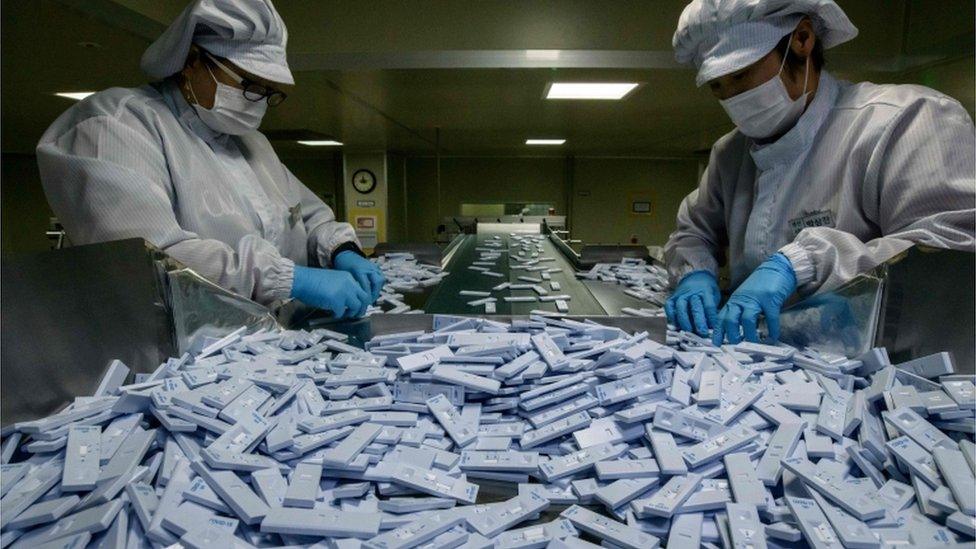
South Korea has set the standard in widespread testing
Levi says the responsibility for this failure lies squarely with the Trump administration, which disregarded pandemic response plans dating back more than a decade to the George W Bush presidency and failed to fully staff its public health bureaucracy.
"The political leadership in this administration really doesn't believe in government," Levi says. "That has really hampered their willingness to harness the resources the federal government had to respond at a time like this."
The numbers, particularly on testing, bear this out. The initial tests sent in February to just a handful of US laboratories by the administration were faulty.
By mid-March, the administration was promising at least 5 million tests by the end of the month. An independent analysis of totals on 30 March, however, indicate only a million tests have been conducted. That's more than any other country but the US population is roughly 329 million people.
What's more, because of crush of testing that has followed the initial shortages, the labs that analyse the results have been overwhelmed, leading to delays of a week or more before tested individuals can learn if they have the virus.
Messaging 'whiplash' and political squabbles
At his press conference on Tuesday afternoon, Donald Trump offered a grim outlook for the nation.
"I want every American to be prepared for the hard days that lie ahead," he said.
His public health advisers followed that statement up with charts predicting at least 100,000 American deaths from the virus even under the current mitigating efforts.
The president's comments stood in stark contrast to remarks even just a week earlier, when he expressed hope that the US could begin to reopen businesses by the mid-April Easter holiday.
In January and February, as the viral outbreak devastated Chinese manufacturing and began exacting a high toll in Italy, the president repeatedly downplayed the threat to the US. Following the first few American cases, Trump and other administration officials said the situation was under control and would dissipate in the summer "like a miracle".
Inconsistent messages from the top are a real problem, Professor Levi says. "Pandemic preparedness is a constantly changing environment, and sometimes your message does change. In this case, however, you've also had whiplash around messages that are not necessarily reflecting a change in the science or what's happening on the ground, but instead reflecting political concerns."
The president has also feuded with Democratic state governors, criticising New York's Andrew Cuomo and belittling Michigan's Gretchen Whitmer on Twitter. He said state leaders needed to be "appreciative" of the federal government.
Social-distancing failures
College students on spring break from classes packed Florida beaches. New York City residents filled subway cars. A church in Louisiana continues to welcome thousands despite pastor Tony Spell being criminally cited for violating an order limiting the size of gatherings.
"The virus, we believe, is politically motivated," Spell told a local television station. "We hold our religious rights dear, and we are going to assemble no matter what someone says."
Across the country, there have been numerous examples of Americans failing to heed the calls by public health professionals to avoid close social contact, sometimes abetted by local and state government officials who have been reluctant to order businesses to shutter and citizens to shelter in place.
"If I get corona, I get corona," one Florida beachgoer told CBS News in mid-March. "At the end of the day, I'm not going to let it stop me from partying."
US students on spring break defy COVID-19 warnings
Even steps taken with the best of intentions might have had adverse consequences. Curtailing public-transportation services, such as New York's subway, may have led to trains and busses that were more crowded. Universities that sent students home to their families may have contributed to the spread of the virus by returning infected individuals to cities, neighborhoods and homes not yet in full lockdown.
The lack of clarity in the president's order to halt entry into the US from Europe - which at first seemed to apply US citizens as well as foreign nationals - led to a crushing crowds at airports where unscreened infected passengers could easily transit the disease to others.
Decisions like those may have had dire consequences, hampering efforts to contain the spread of the disease throughout the nation - the public health equivalent of throwing petrol on an already raging fire.


A SIMPLE GUIDE: What are the symptoms?
US v ITALY v CHINA: How do death rates compare?
LEADING THE WAY: The US governor who saw it coming early
ON FRONTLINE: 'Nurses prepare for the worst but not this'
REASON TO HOPE: The good that may come out of this crisis


SUCCESSES
Stimulus Goliath
Last week the US Congress passed a $2tn coronavirus relief bill, which included direct cash payments to many Americans, expanded unemployment assistance, aid to states, healthcare facilities and other public services, support for hardest-hit industries, and loans to small- and medium-sized businesses that can be forgiven if they avoid layoffs.
It was a massive, record-breaking piece of legislation that was the result of negotiations involving Democratic and Republican leaders in Congress, as well as Treasury Secretary Steve Mnuchin and his deputies.
"This should be described as a survival bill, not a stimulus bill," says Columbia's Graetz, author of the book The Wolf at the Door: The Menace of Economic Insecurity and How to Fight It.
"Everybody has things they don't like or they wish for better, no one is going to be satisfied with it," he says, "but I think it should get pretty high marks for a beginning."

Part of the challenge for lawmakers, Graetz says, is the current system of unemployment insurance for American workers is woefully outdated - a patchwork of state-run programmes with varying benefits and qualification requirements ill-suited for the modern economy. Congress attempted to address this in the coronavirus legislation by ensuring that freelance and gig-economy workers are covered and temporarily supplementing the existing benefits.
"It's going to be too little for a lot of people, but it was the only solution available," he says. "Congress started this process with a very weak hand in terms of a solid system of social protections or safety nets that it could build on."
Both Trump and Democratic Speaker of the House Nancy Pelosi have already talked about working on another aid bill, perhaps with infrastructure investment and additional healthcare benefits, suggesting this recent bipartisan co-operation is just a beginning.
Research firepower
If the coronavirus is exposing some of the flaws in the US healthcare system - high costs, a lack of universal coverage and supply chains that are unable to withstand a shock - it also could end up highlighting the strength of the nation's research and drug development infrastructure.
Pharmaceutical manufacturers and medical researchers are rushing to learn more about the virus in an attempt to devise new strategies to defeat the pandemic.
One company has developed a new fast-response test that can identify those carrying the virus almost immediately, ending the current testing backlog and allowing public health officials to quickly identify new outbreak hotspots and make quarantining decisions.
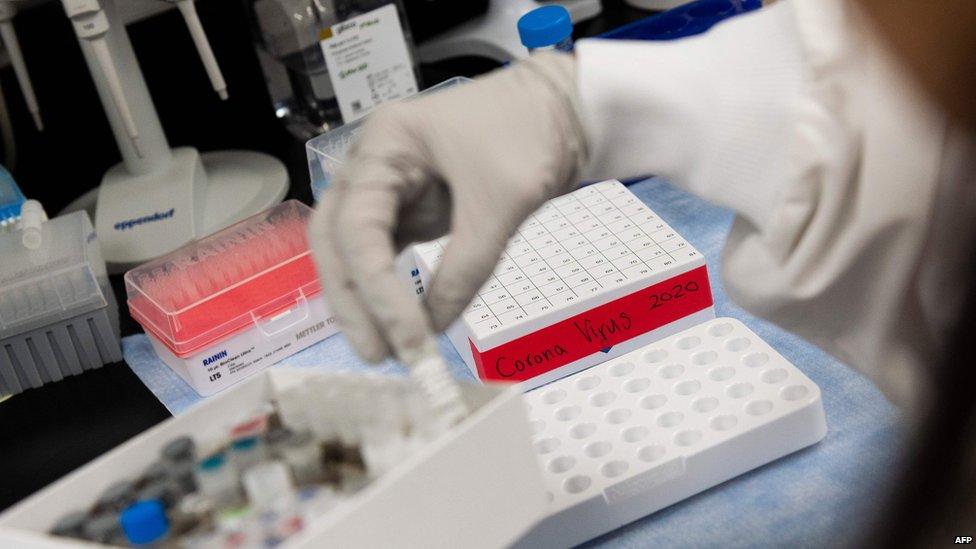
"The long-term prospects around vaccine and therapeutic development is more encouraging," Levi says. "The science is getting done."
He adds that pharmaceutical companies that are researching treatments and cures are receiving assurances from the government that there will be a market for their products and they will be adequately compensated for their investments. The problem, he says, is that the efforts made today will take months - or longer - before they show results.
Anthony Fauci, director of the U.S. National Institute of Allergy and Infectious Diseases, predicted that it would be at least a year before a widespread vaccine is available. The goal of public health policy for now is to limit the toll the virus takes on the population until that day arrives.
State leadership
The US federal system of government, which delegates broad powers to individual states, has proven to be both a blessing and a curse. In good times, it allows local leaders to experiment individually with various public policy solutions, testing out best practices that can then be adopted across the nation.
In the case of a deadly pandemic, however, a patchwork response can be inadequate - and result in avoidable deaths and economic disruption.
"Every governor is making decisions on their own," Levi says. "Some are making good decisions; some are not."
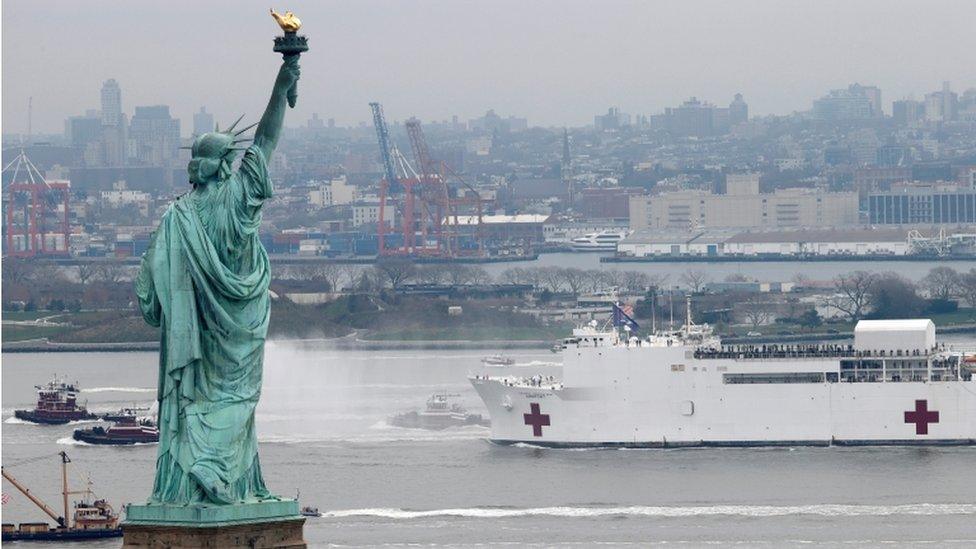
The US Navy hospital ship USNS Comfort passes the Statue of Liberty
He points to governors like Gavin Newsom of California and Jay Inslee of Washington, who took early steps to close schools and issue shelter-in-place orders that have resulted in a slower spread of the virus in their populations.
Ohio Governor Mike DeWine has also received praise from many quarters for his decisive early moves that at the time were viewed by some as too drastic.
Health officials say most major US metropolitan areas were going to be hit has hard as New York City has been. That, they said, may not end up being the case.
Some states are working hard to avoid suffering New York's fate, but Levi warns that their efforts may be hampered by other locations not doing nearly enough.
"The problem we have in the US," he says, " is the capacity to respond varies so dramatically on a state-by-state basis because of the willingness to invest in public health."
"We are only as protected as the weakest states."
- Published31 March 2020
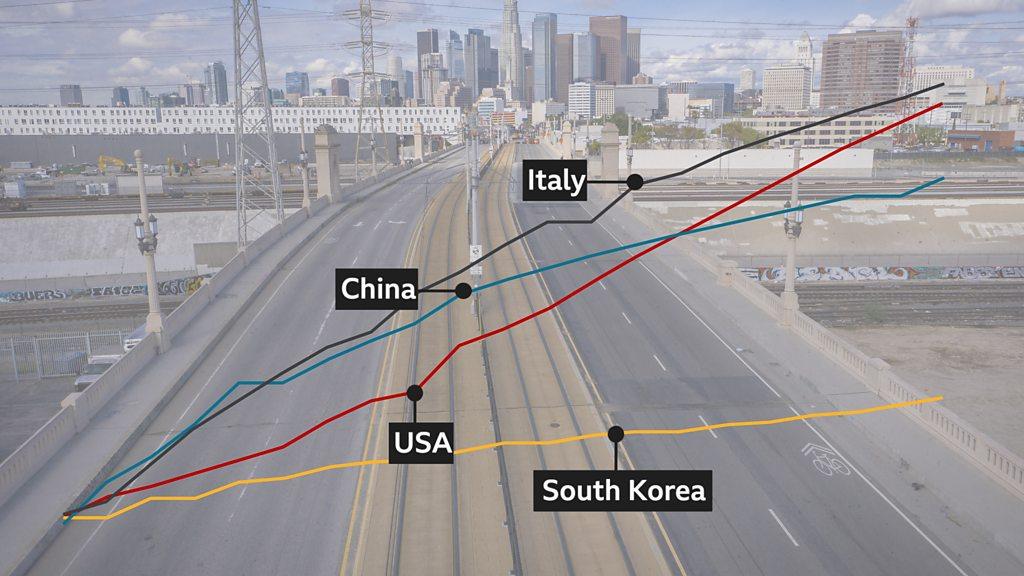
- Published31 March 2020
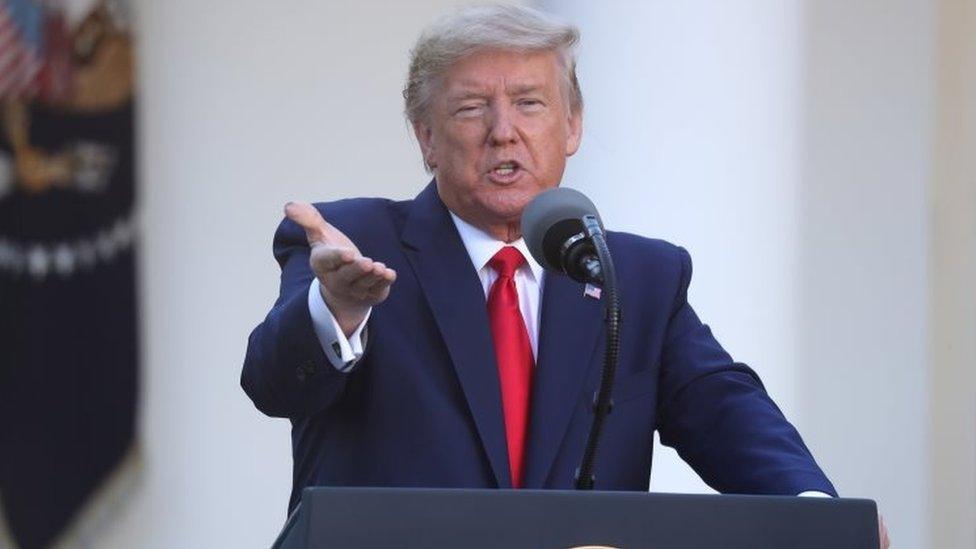
- Published29 March 2020
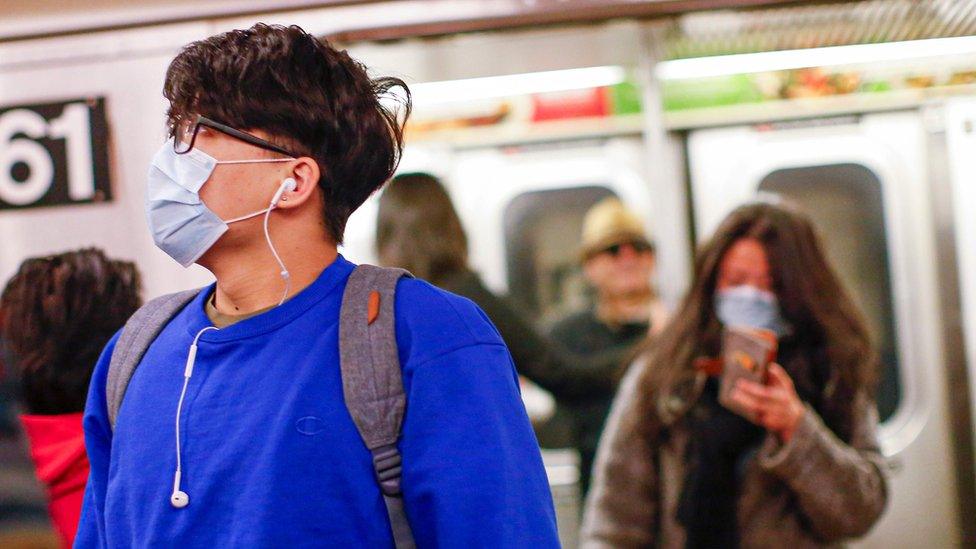
- Published29 March 2020

- Published24 March 2020
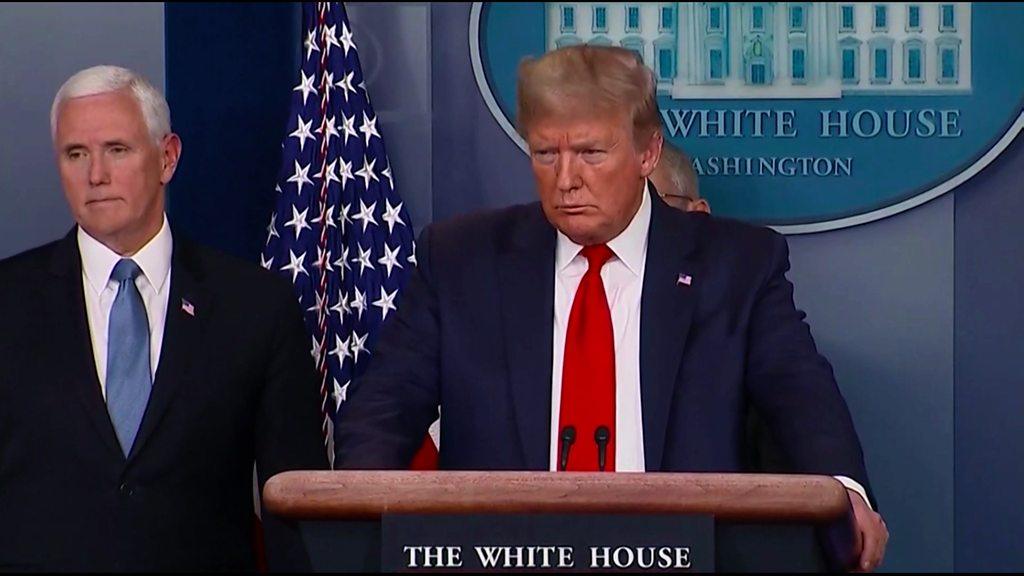
- Published28 March 2020

- Published26 March 2020
